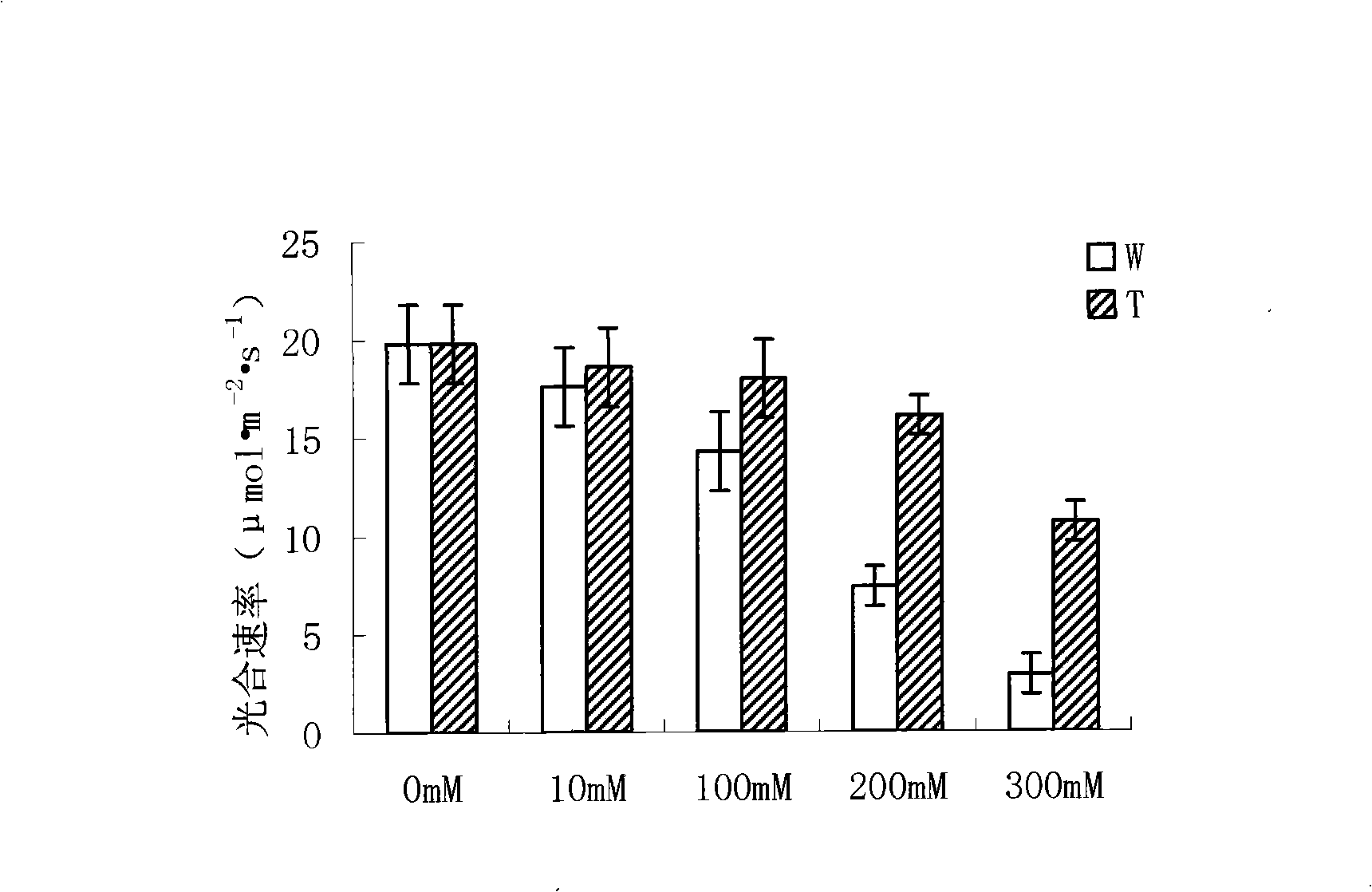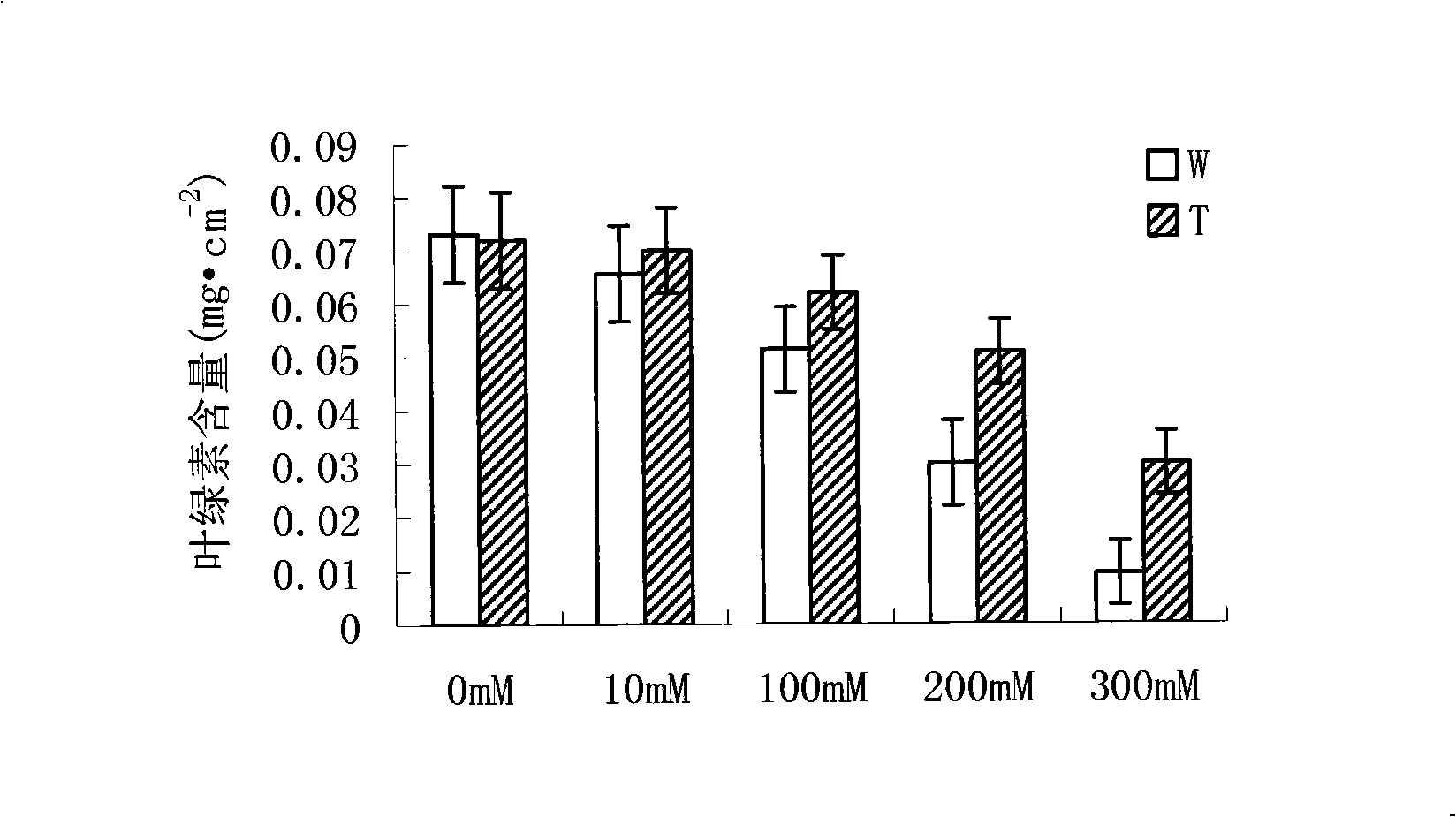Guinea grass Na+/H+ reversal transportation protein gene sequence and its clone and application
A technology of antiporter and gene, applied in the field of molecular biology and biology, can solve problems such as less obvious effects
- Summary
- Abstract
- Description
- Claims
- Application Information
AI Technical Summary
Problems solved by technology
Method used
Image
Examples
Embodiment 1
[0085] Embodiment 1: Leymus chinensis Na + / H + Cloning method of antiporter gene
[0086] 1. Extraction of total RNA: Total RNA was extracted using RNAeasy mini kit (product of Promoga).
[0087] 2. Synthesis of the first strand of cDNA: take 2 micrograms of total RNA, add 4 μl of 5× reaction buffer, 2 μl of 10 mM deoxyribonucleic acid (dNTP), 0.5 μl of ribonuclease inhibitor (40-200u / μl), primer T26 (10 pmol / μl) 1 μl, reverse transcriptase (10u / μl) 2 μl, react at 42°C for 60 minutes, and stop the reaction at 85°C for 10 minutes.
[0088] 3. PCR reaction: polymerase chain reaction (PCR) reagents and conditions are:
[0089] First mix the following reagents together:
[0090] 10×Reaction Buffer 5μl
[0091] 10mM deoxynucleotide mixture (dNTP) 1μl
[0092] Forward primer (10μM) 2μl
[0093] Reverse primer (10(M) 2μl
[0094] Template cDNA 1μl
[0095] Taq DNA polymerase 0.5μl
[0096] Total volume 50μl
[0097] The PCR reaction conditions were: 94°C for 5 minutes, an...
Embodiment 2
[0103] Embodiment 2: Leymus chinensis Na + / H + The sequence determination of the antiporter gene AcNHX was carried out at Shanghai Sangon Bioengineering Technology Service Co., Ltd.
[0104] 7. Separation of 3' and 5' sequences: according to the instructions of SMART RACE cDNA Amplification Kit of Clontech Company
[0105] Leymus chinensis + / H + The amino acid sequence of the antiporter gene AcNHX1 and its encoded protein is as follows:
[0106] (1) Information on SEQ ID NO 1
[0107] (a) Sequential features
[0108] * Length: 2022 bp
[0109] *Type: nucleic acid
[0110] * Chain type: double chain
[0111] *Topology: Linear
[0112] (b) Molecular type: cDNA
[0113] (c) Assumption: No
[0114] (d) Antisense: no
[0115] (e) Original source: Leymus chinensis
[0116] (f) Sequence description: SEQ IN NO.1
[0117] ATGGGGTTCGAAATAGTGACGGCGCAGCTGGCGCGGCTGAGCGGCGCGCTGGGCACCTCG----60
[0118] GACCACGCGTCCGTGGTCTCCATCAACCTCTTCGTGGCGCTGCTCTGCGCCTGCATCGTC---120
[01...
Embodiment 3
[0167] Embodiment 3: Construction of expression vector
[0168] 1. According to the isolated Leymus chinensis Na + / H + Nucleotide sequence of antiporter gene NHX1, designed primers:
[0169] Forward primer: 5′-CGGTCTAGAATGGGGTTCGAAATAGTGAC-3′
[0170] Reverse primer: 5'-TATGAGCTCTCATCCCACGTGTACATTCG-3'
[0171] The polymerase chain reaction was performed using the cDNA reverse-transcribed from the total RNA of leaves as a template.
[0172] 2. Take 2 μl of PCR and connect it with the pMD18-T vector, and the operation steps are carried out according to the instructions of the product pMD18-TVector system of Promega Company. Then transform E. coli DH5α strain and grow overnight on LB plates coated with 5-bromo-4-chloro-3-indole-β-D-galactoside and X-gal containing ampicillin (100 μg / ml) . Pick white colonies and culture them overnight in LB liquid medium. Plasmid DNA was extracted by alkaline method and sequenced.
[0173] 3. The gene was excised from the pMD18-T vector...
PUM
 Login to View More
Login to View More Abstract
Description
Claims
Application Information
 Login to View More
Login to View More - Generate Ideas
- Intellectual Property
- Life Sciences
- Materials
- Tech Scout
- Unparalleled Data Quality
- Higher Quality Content
- 60% Fewer Hallucinations
Browse by: Latest US Patents, China's latest patents, Technical Efficacy Thesaurus, Application Domain, Technology Topic, Popular Technical Reports.
© 2025 PatSnap. All rights reserved.Legal|Privacy policy|Modern Slavery Act Transparency Statement|Sitemap|About US| Contact US: help@patsnap.com



